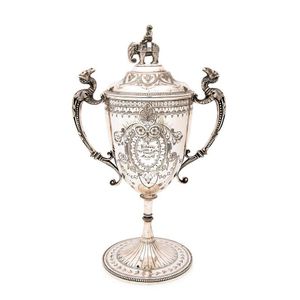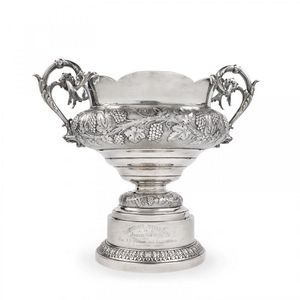Edwardian Sterling Silver Jubilee Cup with Grapevine Decoration
You must be a subscriber, and be logged in to view price and dealer details.
Subscribe Now to view actual auction price for this item
When you subscribe, you have the option of setting the currency in which to display prices to $Au, $US, $NZ or Stg.
- Sterling Silver - Sterling silver is a mixture of 92.5% pure silver and 7.5% of another metal, usually copper. Fine silver is 99.9% pure silver, and is relatively soft and the addition of the very small amount of copper gives the metal enough strength and hardness to be worked into jewellery, decorative and household objects.
- Hallmarks - A mark stamped on articles of precious metals in Britain, since the 14th century, certifying their purity. It derives its name from the Guild Hall of the Goldsmiths' Company, who recieved its Charter in 1327 giving it the power to assay (test the purity) and mark articles of gold and silver.
The hallmark will consist of several marks, including the:
- silver standard mark, indicating the purity of the metal. Sterling silver is .925 pure silver.
- the city mark indicating the city in which it was assayed eg London, Birmingham, York etc.
- the date mark, usually a letter of the alphabet in a particular font and case,
- a duty mark, indicating whether duty had been paid to the crown, and only in use from 1784 to 1890
The piece may include an additional mark, the maker's mark, although not forming part of the hallmark, will be located in the vicinity of the hallmarks.
Sometimes silver plated items will bear faux hallmarks, often confusing those not familiar with silver markings. - Acanthus - A stylized leaf motif, one of the primary decorative elements of classical Greek and Roman architecture, derived from the genus of flowering plants in the family Acanthaceae, native to tropical and subtropical regions of the Mediterranean area. It is a common element in classical Greek and Roman design, and is often seen in Corinthian and Composite order columns and used as a decorative element in English, European and Australian furniture, particularly on the curve of a leg, and as decoration for a corbel.
- Embossed / Repousse - Embossing, also known as repousse, is the technique of decorating metal with raised designs, by pressing or beating out the design from the reverse side of the object.It is the opposite of chasing, where the decoration is applied from the front. An embossed or repoussed object may have chasing applied to finish off the design.
- Edwardian - The Edwardian period of English furniture and decorative arts design is named for Edward VII (1841 ? 1910) who was King of the United Kingdom and the British Dominions and Emperor of India for the brief period from 1901 until his death in 1910. It follows the Victorian period, in turn was followed by the Art Nouveau and Art Deco styles. In Australia, designs of this period are also known as being in the Federation style.
- Frank Hyams Ltd. - Frank Hyams purchased a jewellery business in Princess Street Dunedin in 1885. As well as a manufacturing jeweller, he was a silversmith and goldsmith and specialised in jewellery incorporating New Zealand greenstone. At the New Zealand and South Seas Exhibition in 1890 he secured "first order of merit" for the manufacture of gold, gem and greenstone jewellery.
Concurrent with his Dunedin store, in 1902 Frank Hyams registered a limited company, Frank Hyams Ltd., and established a business in London, at 167 New Bond Street, and later at 128 New Bond Street, London, trading as 'artistic jewellers, gold and silversmiths, and dealers in gems of rarity'.
Frank Hyams established a reputation within the English aristocratic and upper class social circles for his unique one-off curiosity pieces incorporating materials and design influences from his New Zealand homeland.
The British Museum has a collection of 36 badges manufactured by Frank Hyams Ltd., circa 1906.
According to the London Gazette, in 1913 at an Extraordinary General Meeting it was voted that the company be voluntarily wound up and Frank Hyams was appointed liquidator.
This item has been included into following indexes:
Visually similar items

Kilmore Pastoral & Agricultural Society silver plated trophy 'Presented by New Zealand Loan & Mercantile Agency Company Ltd', by Roberts & Belk, the design registered 13 June 1878, late 19th century, 34 cm high

A Dublin silver cup, possibly late Georgian with worn marks with C scroll and flower head chased decoration, 13 cm high, 447g

A Chinese silver dragon handled goblet, early 19th century, marked Sun Shinh, Canton. Stamped SS to base, approximately 30 cm high, 26 cm diameter. 871 gms silver

Sterling silver two handled cup, Dublin, C1750. Maker E.R (with cross above) engraved Allport 1853. The embossing on this cup is possibly the work of employed convict silversmith Joseph Forrester. 12.5 cm high, weight 460gms Provenance: Allport Family
